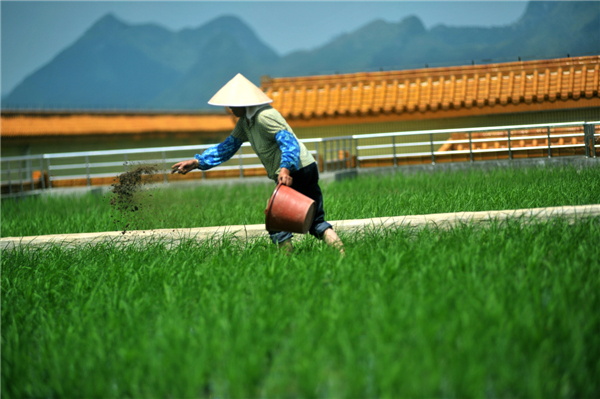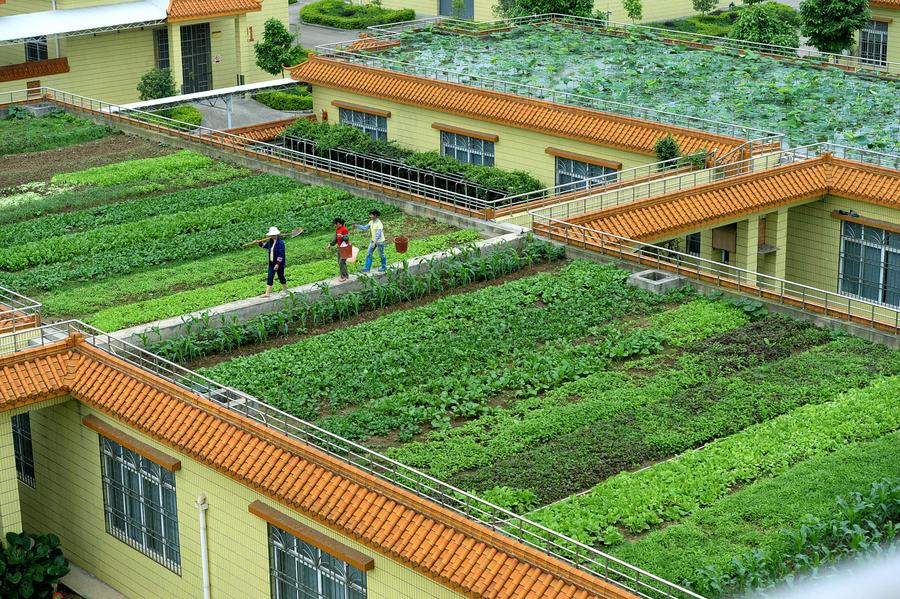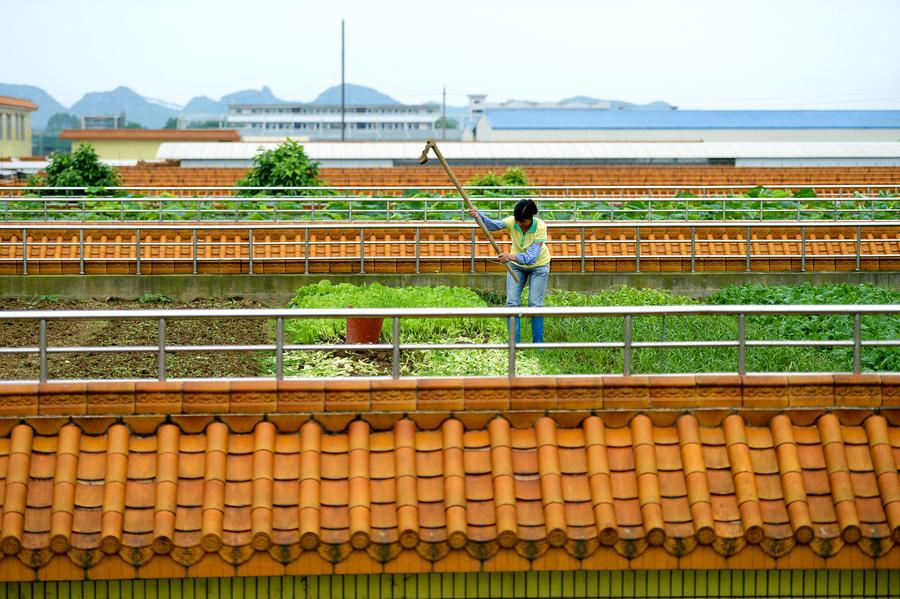rooftop rice paddy

Fertilizing rooftop rice in Liuzhou, China || photo by Xinhua
Two hectares of rooftop in South Central China’s Guangxi Zhuang Autonomous Region stand a cut above the rest. The Liuzhou Chenfeng Brewing Factory, founded in 1954, supports one of China’s only rooftop rice paddies. Tan Zhaohan, the factory’s head rice planter, reported to David Cao of Bejing Impact that the roofs were first planted in 2010. Rice, lotus and vegetables flourish on the roof while other crops are grown on the property at ground-level.

Vegetable, lotus and rice crops flourish on the brewery roofs || photo by Xinhua
According to Zhaohan, the brewery’s owner developed this agricultural rooftop vision and took the necessary steps to enhance each roof area’s waterproofing membrane. This process likely involved either patching and testing the existing membrane for water tightness (i.e. leaks) or applying a new membrane altogether. Water pumped from underground is ponded on the roof thanks to six drains on each roof with adjustable collars. The collars allow workers to adjust the rice paddy’s water level depending on crop needs.
Ponding water on rooftops is a common practice today in cities like New York, where local stormwater regulations incentivize a reduction in peak delay. Allow me to explain. During a rain event or snow melt event, water hits roofs, streets and other impervious surfaces and rushes to the storm sewer, often overloading the system. When we’re able to delay the rate at which water flows to the sewer after such an event, that’s called reducing the peak delay. On rooftops this delay can be achieved through green infrastructure such as green roofs, or by ponding water for 24 hours within a blue roof. Another type of rooftop ponding, common in Germany, involves ponding 1″-2″ of water at the base of a green roof to provide base-level irrigation water to the plants. A third example of rooftop ponding has been articulated by historian Geoff Wilson, who believes that the Hanging Gardens of Babylon (in present-day Iraq) may have supported rooftop aquaculture, or fish farming, for the building’s residents.

Skyline farmers in Liuzhou, China || photo by Xinhua
While rooftop ponding is clearly nothing new, its use for growing commercial grain and vegetables is astounding. I must admit that I’ve been asked about the feasibility of growing rice on rooftops several times throughout the years, and have brushed off the question as an impossibility each time. After recently learning of the Liuzhou Chenfeng Brewing Factory roof, though, I am shamed! Cultivating rooftop rice is indeed feasible given proper growing and architectural conditions.
Why build a rooftop rice paddy, you ask? The benefits are twofold. First, the rooftop farm provides fresh, in-house produce to the brewery below for beer making, wine making and other uses. This on-site production may result in monetary savings to the brewery because the business would need to buy fewer ingredients. Given the size of the roof areas, though, it’s likely that most ingredients are still purchased from producers or suppliers.

Cultivating rooftop vegetables || photo by Xinhua
Secondly, the brewery’s manager, Liu Xinsheng, reported to Bejing Impact that the rooftop farm helps to moderate the buildings’ indoor temperature, thereby saving the company money on utility bills. This makes sense, because water holds heat longer than a bare membrane roof. As outdoor temperatures fluctuate, the water within Liuzhou Chenfeng Brewing Factory’s rice paddies remains relatively constant. During the heat of day the paddies reduce the need for indoor air conditioning. Additionally, the brewery is only one story tall, which furthers the ability of the rooftop farm to keep the building cool. Temperature control via green roofs and blue roofs is a function of the area of the roof relative to the volume of the building, which means that low (1-2 story) buildings reap the largest temperature benefits.
The potential for cultivating rooftops for culturally-relevant crops is expanding, thanks to rooftop farms such as that atop the Liuzhou Chenfeng Brewing Factory. Let’s wait and see what impossibilities become possible around the world as creative thinkers transform their rooftop acreage.
 EAT UP
EAT UP
Great and very interesting story!
Thanks, Jeff! It seems the only thing they’re missing is a rooftop greenhouse!
It seems that the only limit to rooftop farming is the imagination!
That’s a great point, Paula! Maybe next we’ll see a rooftop fish farm, although I’m still holding out for skyline oyster beds.
Look impressed but still a lot of things to think about! , such as drainage system, how much moisture relative in the building, the foundation of the building is calculated for this or not etc.
You bring up great points of consideration, Valairat! The one thing I can tell you about drainage is that the adjustable collars were installed onto the building’s roof drains so that the farmers can regulate the amount of water that rests on the roof. As for load forces on the building’s foundation, it would have been the structural engineer’s job to review the condition. Thank you for your comment!
i am planning starting a rice farm on roof top by new year. for this now i am water proofing roof.since iam fear of roof stability iam using car sheds top by applying uv stabilised tarpolin to contain coir pith
Benson, this sounds like a great project. In what city is the building or car shed? We’d love to hear more details!
waw very amazing. i wish agriculture in my country weill be that goood too… waaw
Thank you for reading the post and commenting! Which country are you from?
Thanks for posting such an interesting and inspiring article. It is great to see a working example of a blue roof. The photos are really beautiful.
Thanks so much! I agree that this is one of the most inspiring food roofs out there.
I have seen cattle being raised at the 31st floor in Shenzhen!